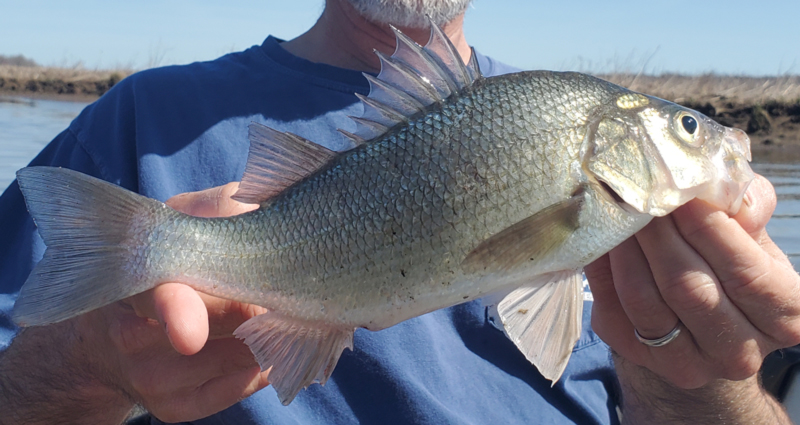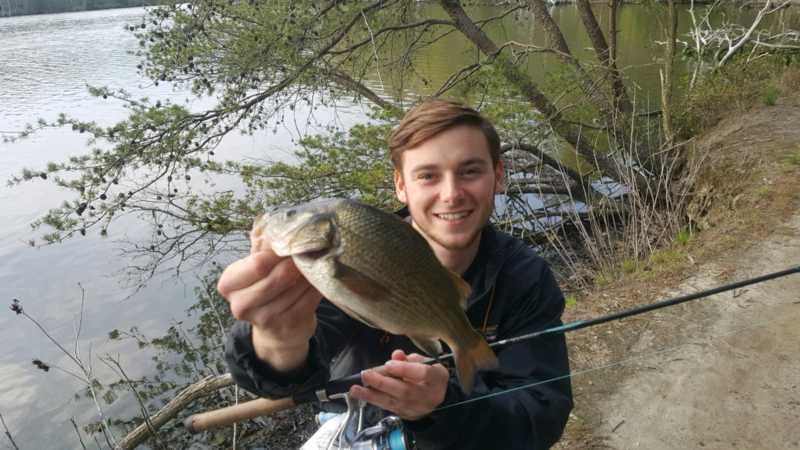As the first signs of spring arrive most of us have yellow perch on the mind, since the “ring perch” run first in the tributaries and March is often a prime time to target them. Look instead to tidal ponds, however, and you can tap into a different but no less attractive early spring fishery: mega-monster white perch.

Like the yellows, when white perch get ready to spawn the first arrivals are the largest of the year. And it’s true that March is a bit early, even for these fish, in many tidal ponds. But if you go fishing before the crowds arrive, you’ll discover that those monster whites will often be found a solid month ahead of the big numbers of perch. You want to catch fish after fish? Then hit the tidal ponds in April. You want to catch a half dozen or so in the 12-plus inch class, and maybe catch the largest white perch you’ve ever seen? March is the time.
White Perch in the Ponds
Countless tidal ponds up and down the shores of the Chesapeake have a spring white perch run. Some have cuts or creeks connecting them to the Bay, but many have little more than a trickle running through a storm drain offering the perch entry. Yet still they come. Those that have a trickle of freshwater feeding them from the other end are best, and most will be just a few feet deep from shore to shore.
How should you choose which one to try? Again, they’re literally countless on both eastern and western shores and we certainly can’t list them all here. In this case, a combination of Google Maps and your local tackle shop is the best recommendation. Look for those ponds that appear on Google Maps to be just barely separated from the Bay or a tributary, or which have a visible connection no larger than a one-lane road. Then ask around at the shops. Put two and two together and you’ll have your spots.
We’ll call out Big Pond at Beverly-Triton Park and Blackwalnut Creek as examples here, not because they’re particularly unusual or exclusive spots but because they offer ideal examples of what to look for. While we wouldn’t encourage anyone to drive for an hour to hit either of these bodies of water, we would encourage you to look at them on Google, then find the similar-looking tidal pond in your neck of the woods. EDITOR'S NOTE: Beverly-Triton has been closed through 11/2022 for construction and improvements.
Tidal Pond Fishing Tactics
When there are tons and tons of seven-inchers next month, you can toss spinners or jigs and catch your fill. But in March the fish are fewer and farther between. Stand on the bank and cast ‘till your arms are sore and sure, you should hook into a fish or three. But fishing bait generally proves far more effective.
Choosing the bait once again differs from April. At that time, grass shrimp are the only game in town. Early on, however, night crawlers can be shockingly effective. Yet for some inexplicable reason, other days it is in fact the grass shrimp that do the trick. The bottom line? Bring both, fish multiple lines, see which gets the bites, and switch over accordingly.

Standard-issue tactics are to fish a bottom rig with number-six hooks and a bobber rig suspending a shad dart two to three feet down. First, the bottom rig: cast out with one hook baited with crawlers and the other with shrimp, then lean the rod up on the old “Y” stick and leave it alone until the tip jiggles. If it doesn’t get any bites for half an hour or more, pull it in and freshen the baits. But also be sure to switch their position. If you had worm on the bottom and shrimp up top, on the next cast make sure it’s shrimp on the bottom and worm up top. Yes, it will make a difference some days.
While the bottom rig soaks bait your dart rig with one or the other offering, cast it out as far as possible, and then work the bobber back as slowly as humanly possible. Don’t just reel, but jiggle your rod tip ever so slightly so that the bobber bounces and quivers the tiniest bit. After fan-casting the area twice with no bites, switch the bait out. By the time you’ve tried both baits it will probably be time to check the bottom rig again.
If either of your rigs gets hit, shift your focus to it for a while. If the bottom rig gets a bite while it’s leaning and you don’t get to it very quickly, you’ll likely miss the fish. But you’ve just gathered intel — for the next 15 or 20 minutes, let the bobber rig drift in the wind while you hold the other rod, ready to set the hook. On the other hand, if your bobber goes down once or twice ignore the bottom rig and focus solely on the float.
If you re-set the bottom rig a couple of times and have fan-casted the bobber four times all around, it’s usually time to move on and try another spot. That said, tide will have an impact. There are days when nothing bites for a couple of hours and then all the sudden the fish turn on. So if you’re at a spot you know has produced in the past, it may be wise to wait out a tidal change.
One note about the bottom rig: many of the tidal ponds have algae growth, sticks, leaves, and other detritus lining the bottom. Try not to drag the rig across the bottom or you’ll likely get fouled or snagged. Instead, after a cast try to sit the rod down with tension on the line while dragging the weight minimally. And when it’s time to check the bait, hold your rod tip high and reel quickly to avoid hooking into all the goop and garbage.

Remember, spending a March day (at least, an early or mid-March day), at a tidal pond is not a numbers game. The end of the month or early April is usually when you’ll load up the stringer. But if you get a half-dozen tidal pond white perch when most anglers think the bite is too slow to bother, that stringer of yours may well end up weighing more than the one holding twice as many fish, next month.
White Perch Fishing Tackle Tips
While you may be targeting the monsters of the perch world, these are still relatively small fish so light gear has plenty of backbone to take them on. It also gives you an advantage when it comes to casting, especially when fishing from shore. Many tidal ponds have overhanging trees that will make it necessary to side-arm cast or use rods no longer than six foot, so making long casts can be tough and light rigs will offer better casting distances. Taking this into consideration, a six-foot ultralight spooled with four- or six-pound test is an ideal rig for tidal pond white perch fishing. If you’re using braid, add a two- or three-foot mono leader to your bobber line. Bobbers should be the small, quarter-size variety, and shad darts in the 1/16th of an ounce range.